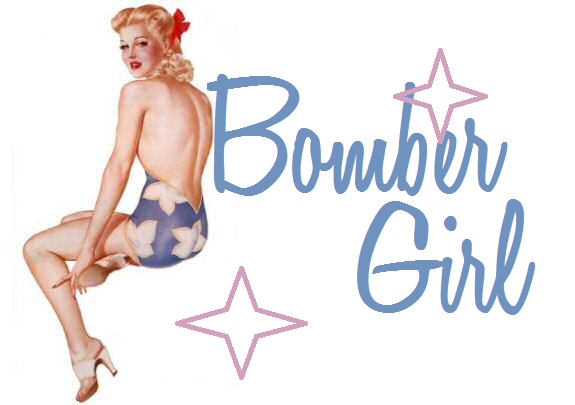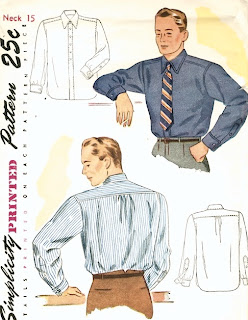 |
| approximately 1840 |
 |
| 1860 |
Now granted men's fashion has changed a bit more slowly than women's fashion in the past few centuries, but we can all agree that it has still evolved fairly quickly.
 |
| 1810 |
 |
| 1910 |
1900s:
 |
| Ca. 1900s (1907ish) |
The type of work shirt you wore, like today, depended on what you did for a living. Business men typically wore suits and white shirts of finer material while day laborers wore more colored shirts of much sturdier fabric (color hides stains and dirt). A man had many shirt patterns and colors available. Polka dots, double stripes and single stripes were popular as well as the traditional white.
 |
| Both acceptable shirting fabrics. |
1910s:
 |
| late teens (source) |
There are two versions of the shirt pictured above. The far left is the negligee version, the center collarless version is what's called an outing shirt. This shirt could also be considered a work shirt if it was made with a sturdier fabric. The type of shirt at this time was determined mostly by the fabric used. Lighter fabrics for casual wear, slightly heavier fabrics for casual wear, and sturdier still for work shirts. The pointed yolk was typically found on casual shirts like these, but on occasion it would pop up in more formal wear.
 |
| From a Guild to Making Shirts reprinted 1928 |
Many colors were still popular at this time. Stripes, half stripes, and even on occasion checked fabrics were worn.
1920s:
 |
| Early 1920s |
During the 1920s the silhouette of the shirt begins to change due in part to improved manufacturing techniques. Shirts become more fitted, with straight fitted sleeves. French cuffs are the norm. Pointed soft attached collars become more and more widespread thanks to the invention of the home washing machine. Rounded detachable collars are still popular among the older population, but for the trendy folks pointed collars become the normal shirt for business wear. They were secured with collar studs or pins and a tie. Detachable collars are still popular among day laborers for their ease of care and increased shirt life.
1930s:
 |
| source |
French cuffs, pointed sleeve plackets, and a longer shirt collar point are all features of this particular shirt. Also popular at this time. Collar stays!
Which were really more like tie clips, but still amazingly effective. Clip stay to tie and each side of collar and voila! Collar stays put all day long. Genus says I.
1940s:
The 1940s bring with it an explosion of different styles of shirts. Shirts become more and more casual. Short sleeve shirts are very stylist for casual wear, sport wear and even work wear.
Fabric choices explode. Flannel, cottons, rayon, prints, prints, prints, and more prints all become popular for work and casual wear.
Western shirts become popular in the late 30s and into the early 40s. This is caused the increased popularity of western movies and stars like John Mack Brown, Red Berry, Harry Carry, Jr. and more. I have a secret love for these, but Mr. Fiance has promised me he will never wear one. Bummer.
The button down business shirts stay about the same. Detachable collars disappear and the softer pointed collar firmly cements its place in men's fashion. Shirt tails become shorter and plackets extend as the waist on men's pants lowers.
And that, my lovely friends, is that. If you found this helpful drop a comment in the comment section below. Next post: 1950s-1960s.
If anyone was confused by some of the terms I used in the post here's a helpful diagram.
 |
| source |
Additional References and Some Good Supplemental Reading Recommendations:













17 comments:
Fascinating post! I love it!!
Was checking out your blog and found this article. Very well done and intelligent, so I'm going out on a limb here and be picky. I'm a seamstress and have been for over 30 years, articles like this fascinate me when they get into the history of fashion and clothing. So please understand I'm not being mean when I say this, it's yoke to describe a part of a man's (or woman's) shirt, not yolk like an egg. Other than that I enjoyed it.
Hello there, love the article!
Was just wondering where you got the 1920s shirt pattern from?
Kind regards,
Blake
Blake,
Ebay. 1920s patterns pop up there very regularly so keep your eyes open. Women's patterns are more common than men's, but they do pop up from time to time. You can expect to pay anywhere from $20-$50 for a good condition pattern. If you have any questions feel free to email me.
best,
Nancy (Bomber Girl)
Wow, thank you for posting this! A timeline of the progression of men’s wear is indeed interesting. My all-time favorite is the Victorian style. The fashion just looks so intimidating and sophisticated that every man must wear it with pride and glory. :]
...the yolks on meeee ...
I am portraying Norton S. Baskin in a play, "Cross Roads: ... " by Deborah B. Dickey, in St. Augustine, Fla, a town that loves to play dress up.
Good info, but do want to clarify that men's shirts were mass produced in enormous quantities in the late 19th century.
I found a really cool mens gift site called www.thegiftsformen.com
Thank you for a great article. I was looking for something to help date some old photographs and this helped so much. I have a question about the first 1900s image (1907ish)where you wrote "a pretty typical late 1900s shirt." Did you mean late 19th Century shirt?
Thanks again for a fascinating story of men's shirts! Connie, Raleigh North Carolina
I really loved reading your blog. It was very well authored and easy to understand. Unlike other blogs I have read which are really not that good.Thanks alot! best golf shirts for men
Thanks for the post! Red Chief presents a vast array of stylish clothes for men that will leave you spoilt for choice.
Thanks for sharing this wonderful content with us. Please also look at Black Wood for Men which is USA Brand for men skin care products which you might like to use on your skin. Black Wood for Men is trusted by Hundred of people of USA.
Outstanding website! Looking for the pista green colour shirts . Browse our selection of men's formal shirts at TheShirtFactory.com. Find a blend of timeless classics and modern styles.
Leather fashion for men always brings a bold and edgy vibe, and this post does a great job highlighting how versatile and powerful leather can be in menswear. For those looking to balance that boldness with timeless elegance, a classic three piece suit for men is a must-have. The right outfit can speak volumes about confidence and personal style.
Excellent blog. searching for the best men's sweatshirts. Discover The sweatshirts Store, where we are committed to creating premium t-shirts that blend classic design with outstanding comfort.
This timeline of men’s shirts is truly fascinating! For anyone wanting to add a bold, timeless layer to modern menswear inspired by these vintage styles, a metallic jacket men is an excellent choice—blending classic tailoring with a contemporary edge.
Post a Comment